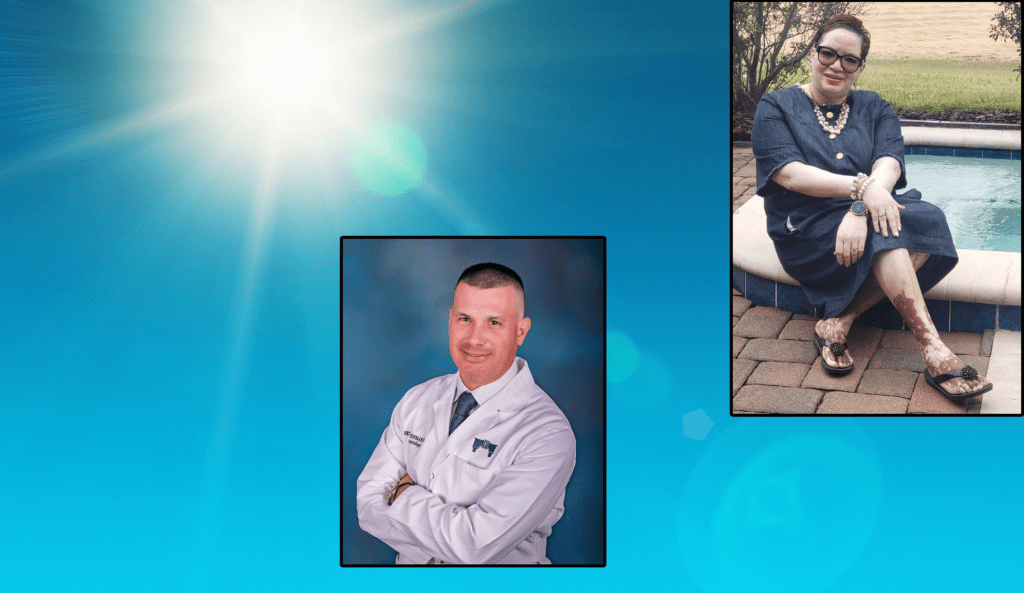Protection Is Key During Florida’s Intense Summers
by PAUL CATALA
Not long after Tonja Johnson was diagnosed, she knew her days out in the direct summer sun were, for the most part, over.
In 2013, Johnson was living in Lakeland and working as a program manager for the Hillsborough County Department of Health. It was around that time that she learned she was one of the approximately 2-4 million Americans who have a disease called vitiligo.
Vitiligo occurs when pigment-producing melanocytes die or stop producing melanin. The disease results in a patchy loss of skin color and it can occur at any age. It tends to progress over time, with larger areas of the skin losing pigment, resulting in patchy white spots. Vitiligo can be caused by an autoimmune disorder, heredity or trauma to the skin.
During the intense, sunny summer months, vitiligo patches easily burn or scar since there isn’t any natural protection from the sun. That means Johnson and others with vitiligo must cover their skin and seek shade during the hottest, brightest days of our Florida summer.
Johnson has now lost more than 85 percent of her skin color and says she sunburns very easily. She must now closely monitor her sun exposure, especially during the summer months.
“Learning to adapt has been important,” she says.
“You really can’t do all the outdoor activities you normally do — theme parks, football games — you’re not able to do any of that,” says Johnson, who in 2017 founded Beautifully Unblemished, a unique vitiligo support group that has connected people with vitiligo throughout the state.
“I wear a lot of protective clothing, sunscreen and try to avoid the direct sun as much as possible,” says Johnson. “I love the water, so I try to find the right time of day to go to the beaches. Early morning or evening is when I have to go. I’ve since gotten comfortable and know what I need to do during the summer. I work hard to avoid direct sunlight during those months.”
For Floridians with vitiligo, summer marks a season of special care, with an emphasis on regularly applying sunscreen, avoiding excessive tanning, wearing protective clothing and avoiding peak sun hours.
Those precautions are important ways to make the summer safe and fun for those with the skin condition, says Dr. Seth Forman, a dermatologist, vitiligo researcher and owner of the ForCare Medical Group in Tampa.
Forman says individuals with vitiligo slowly lose normal skin tone, “which is very disturbing to them.” He says the summer months make that loss unpredictable, losing little skin color some days, then much more on others.
Forman says the areas without pigmentation are more susceptible to sunburn and skin cancer during the summer.
To help protect the skin, Forman suggests using sunscreen with a Sun Protection Factor of at least 15. However, he says he prefers the protection that clothing can offer.
“I prefer protective clothing more than sunscreen, no matter what the issues are, for those with or without vitiligo,” says Forman, a graduate of the Medical College of Virginia in Richmond.
As for sunscreen, Forman recommends any type that protects against Ultraviolet A and Ultraviolet B sun radiation. UVA has a longer wavelength and is associated with skin aging; UVB has a shorter wavelength and is associated with skin burning.
“That’s why when you buy sunscreen, you have to make sure it’s broad-spectrum; that means it has the UVB protection and the UVA protection,” he says. “You need sunscreen with both, but I still think physical blockage (clothing) is best,” he says, saying some clothing is now manufactured with sun-protection factors woven in. He says this type of material is ideal to wear in the water because it dries quickly.
Forman says it’s also advisable for everyone, but particularly those with vitiligo, to stay out of the sun during the peak hours of 10 a.m. to 4 p.m.
Another factor to consider is cloud cover. Clouds don’t block any UV rays, so even if it’s cloudy or overcast, sunscreen is still a necessity.
Forman recommends that those with vitiligo who wear makeup use UV-blocking makeup, such as a high-quality concealer that is smudge-proof, sweatproof and moisture-resistant.
If sunburn does affect exposed areas of vitiligo, he says, all you can do is treat the burn and try not to do it again.
“Depending on the sunburn damage, you can take an over-the-counter pain reliever and use aloe,” he says. “But once you have a sunburn, you can’t reverse it. You just have to treat it supportively. The key is to provide sun protection, whether it be with sunscreen with SPF greater than 15, but I prefer protective clothing. They’re both important.”
